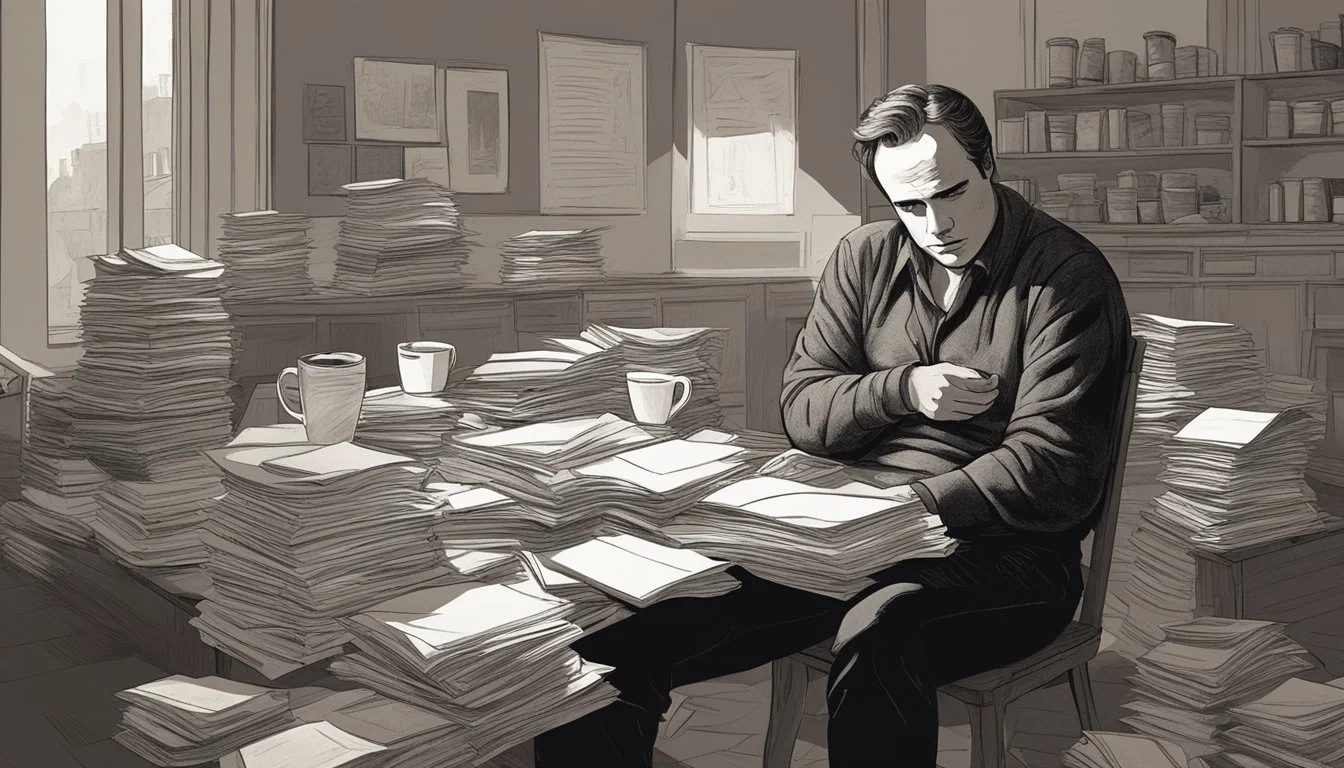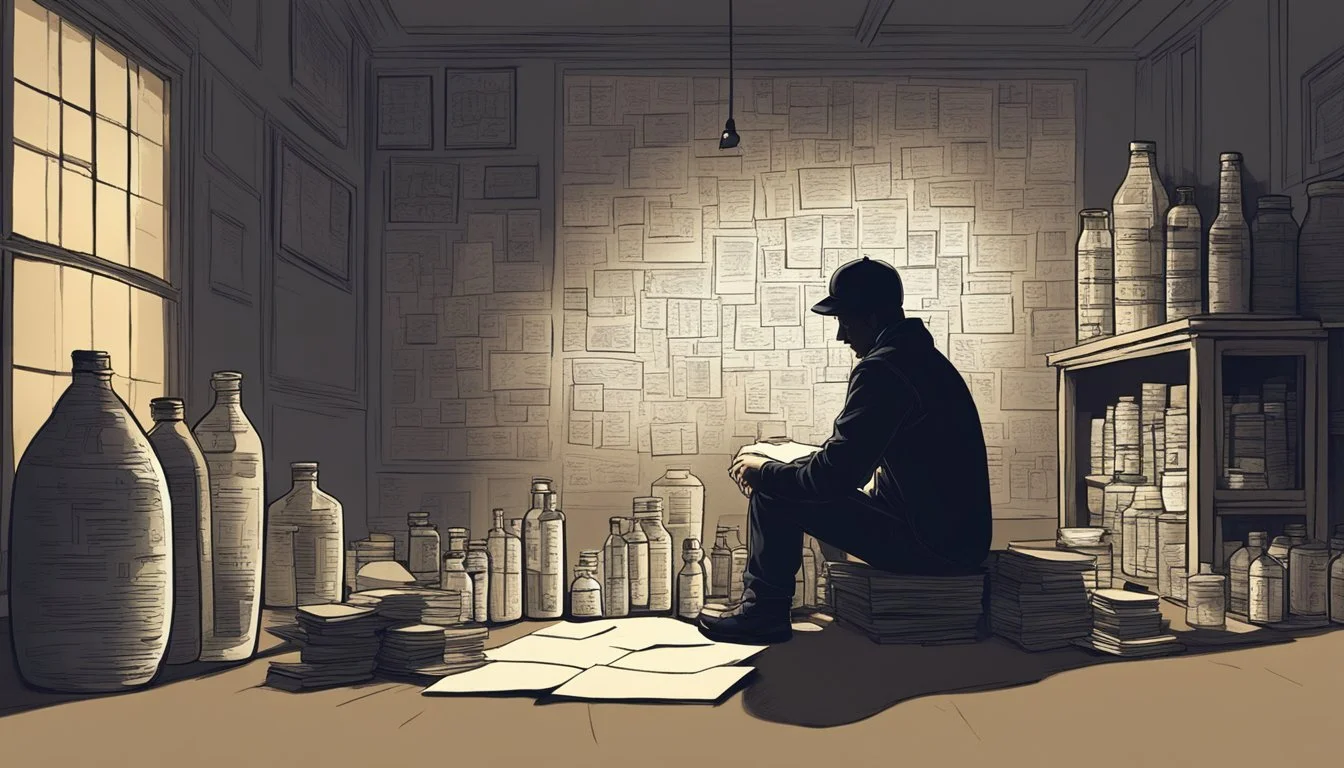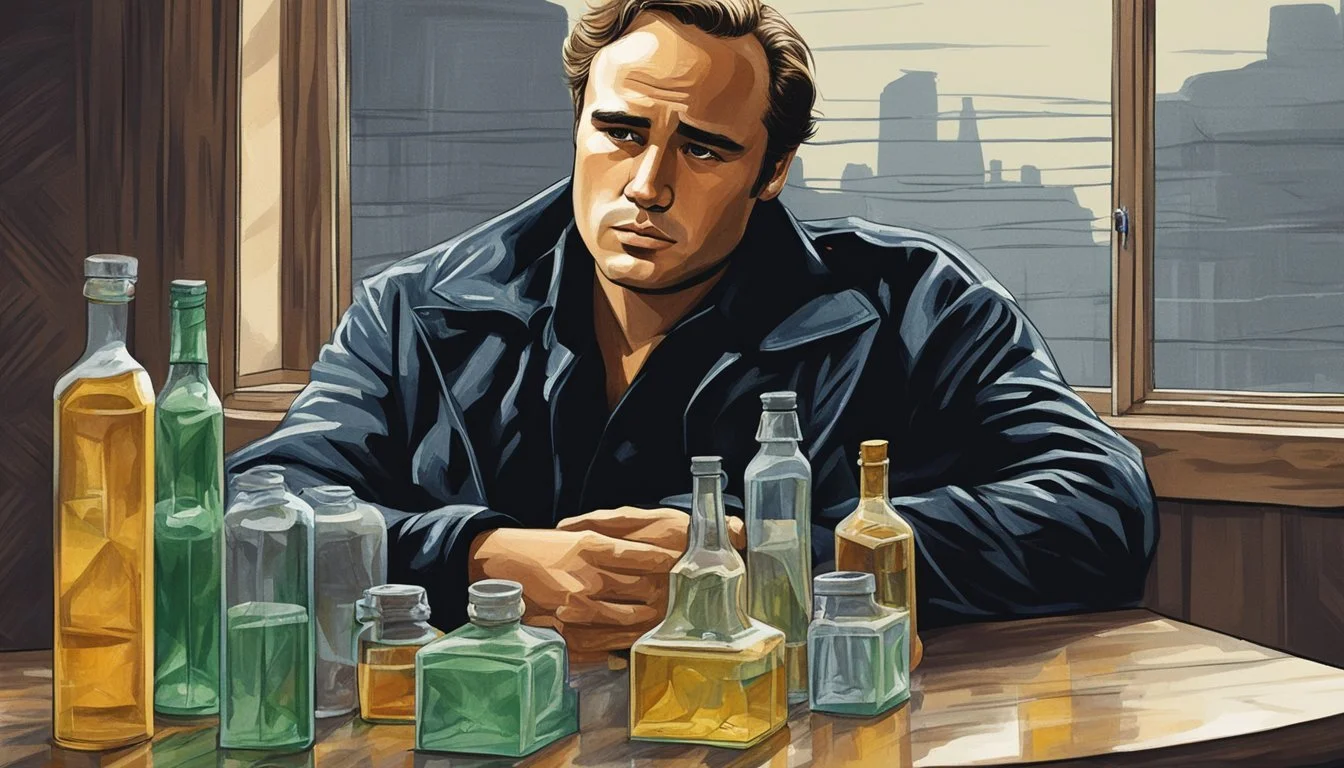Method and Melancholy: Marlon Brando's Battle with Depression
The Untold Struggles of a Hollywood Icon
Marlon Brando, a titan of American cinema, revolutionized acting with his raw, emotive performances. His commitment to method acting brought unprecedented realism to the silver screen, captivating audiences and critics alike. Yet beneath the surface of his remarkable talent lay a profound struggle with depression that shaped both his art and his life.
Brando's approach to his craft was deeply intertwined with his personal experiences and emotions. He drew from his inner turmoil to create characters of startling depth and complexity. This introspective technique allowed him to deliver iconic performances in films like "A Streetcar Named Desire" and "On the Waterfront," but it also exacted a heavy toll on his mental health.
Throughout his career, Brando grappled with the weight of fame and the demands of Hollywood. His battles with depression often manifested in erratic behavior on set and in his personal life. Despite these challenges, Brando's influence on acting remains undeniable, leaving an indelible mark on the industry and inspiring generations of performers to explore the depths of human emotion.
Marlon Brando: Life and Career
Marlon Brando's journey from a troubled childhood to Hollywood legend was marked by groundbreaking performances and a rebellious spirit. His innovative acting style revolutionized cinema and inspired generations of actors.
Early Life and Broadway Beginnings
Born in 1924 in Nebraska, Marlon Brando faced a turbulent upbringing. His parents, Marlon Sr. and Dorothy, struggled with alcoholism. The young Brando endured his father's violent outbursts and criticism.
Despite these challenges, Brando found his calling in acting. He moved to New York City in his early twenties to study at the Dramatic Workshop of The New School.
In 1944, Brando made his Broadway debut. His breakthrough came in 1947 with his portrayal of Stanley Kowalski in Tennessee Williams' "A Streetcar Named Desire." The raw, emotional performance showcased Brando's talent and hinted at his future stardom.
Rise to Stardom: 'A Streetcar Named Desire'
Brando's Broadway success in "A Streetcar Named Desire" catapulted him to Hollywood. He reprised his role as Stanley Kowalski in the 1951 film adaptation, directed by Elia Kazan.
The film was a critical and commercial triumph. Brando's intense, naturalistic portrayal of Kowalski earned him his first Academy Award nomination and cemented his status as a leading man.
This performance introduced mainstream audiences to Method acting, a technique Brando had studied under Stella Adler. His approach to the role set new standards for realism in film acting.
Iconic Film Roles and Method Acting
Brando's career soared throughout the 1950s and 1960s. He delivered unforgettable performances in films like:
"The Wild One" (1953)
"On the Waterfront" (1954) - won Best Actor Oscar
"The Godfather" (1972) - won Best Actor Oscar
"Last Tango in Paris" (1972)
His commitment to Method acting brought depth and authenticity to his characters. Brando immersed himself in roles, often improvising dialogue and drawing from personal experiences.
This approach influenced a new generation of actors, including Robert De Niro and Al Pacino. Brando's style emphasized emotional truth over theatrical presentation.
Challenges and Controversies
Despite his success, Brando faced personal and professional challenges. His reputation for being difficult on set grew as his career progressed.
He gained weight and became selective about roles, often choosing projects for financial reasons rather than artistic merit.
Brando's personal life was tumultuous. He married three times and fathered numerous children. Tragedy struck in 1990 when his son Christian was convicted of manslaughter.
In later years, Brando became reclusive. He continued to act sporadically but focused more on environmental and social causes. His final years were marked by health issues and family troubles.
Marlon Brando's Filmography
Marlon Brando's career spanned over five decades, featuring iconic performances that revolutionized acting. His filmography showcases a mix of critically acclaimed roles and commercial successes that cemented his status as a Hollywood legend.
Critically Acclaimed Performances
Brando's breakout role came in 1951 with "A Streetcar Named Desire," earning him his first Oscar nomination. In 1953, he starred in "The Wild One," portraying a rebellious biker gang leader.
His portrayal of Terry Malloy in "On the Waterfront" (1954) won him his first Academy Award for Best Actor. The famous "I coulda been a contender" scene is widely regarded as one of cinema's greatest moments.
In 1961, Brando directed and starred in "One-Eyed Jacks," a unique Western that showcased his versatility. He followed this with challenging roles in "Mutiny on the Bounty" (1962) and "The Chase" (1966).
The Godfather: A Defining Role
Brando's portrayal of Vito Corleone in "The Godfather" (1972) is often considered his most iconic performance. He won his second Academy Award for Best Actor for this role, though he famously declined to accept it.
His understated yet powerful performance as the aging mafia boss redefined his career and influenced a generation of actors. The film's success reignited public interest in Brando's work.
Following "The Godfather," Brando starred in the controversial "Last Tango in Paris" (1972), which pushed boundaries with its explicit content and raw emotional performances.
Last Stages of Career
In the latter part of his career, Brando became more selective with his roles. His portrayal of Colonel Kurtz in "Apocalypse Now" (1979) remains a haunting and memorable performance.
He appeared in the environmental thriller "The Formula" (1980) and took on supporting roles in films like "A Dry White Season" (1989), which earned him an Oscar nomination.
Brando's final film appearance was in "The Score" (2001), where he starred alongside Robert De Niro and Edward Norton, bringing together multiple generations of method actors.
Method Acting and Its Impact
Method acting revolutionized performance techniques in Hollywood, emphasizing emotional authenticity and psychological realism. This approach profoundly shaped acting styles and influenced generations of performers.
The Method Approach
Method acting encourages actors to draw from personal experiences to create genuine emotional responses. Actors immerse themselves in their characters' psyches, often maintaining roles off-camera. This technique aims to produce raw, honest performances.
Elia Kazan, a key figure in popularizing the Method, directed Marlon Brando in "A Streetcar Named Desire." Brando's portrayal of Stanley Kowalski showcased the power of this approach, bringing a new level of intensity to the screen.
The Method emphasizes improvisation and moment-to-moment authenticity. It pushes actors to react naturally to their surroundings and fellow performers, creating a sense of spontaneity.
Influence on Peers and Successors
Brando's groundbreaking performances inspired a generation of actors. James Dean, Montgomery Clift, and Paul Newman embraced the Method, bringing a new depth to their roles.
The impact of Method acting extended beyond individual performances. It transformed the entire landscape of American cinema, encouraging more realistic storytelling and character development.
Directors like Arthur Penn incorporated Method techniques into their filmmaking processes. This symbiosis between acting and directing led to more collaborative and psychologically nuanced productions.
Method acting's influence continues today. Many contemporary actors still draw from its principles, adapting them to modern filmmaking techniques and audience expectations.
Personal Struggles and Mental Health
Marlon Brando's life was marked by intense emotional challenges and inner turmoil. His rise to fame and personal battles with depression shaped both his career and private life in profound ways.
Dealing with Fame
Brando's meteoric rise to stardom in the 1950s brought immense pressure and scrutiny. He struggled to reconcile his public image with his intensely private nature. The actor often retreated from the limelight, seeking solitude on his private island in Tahiti.
His rebellious spirit clashed with Hollywood norms, leading to tension with studios and directors. Brando's unconventional behavior on set became legendary, sometimes disrupting productions.
Despite his success, he remained deeply ambivalent about his fame and acting career. He once remarked, "Acting is the expression of a neurotic impulse. It's a bum's life."
Marlon's Battle with Depression
Throughout his life, Brando grappled with severe depression. His mood swings and dark periods affected his work and relationships. The actor's childhood traumas, including an alcoholic mother and abusive father, likely contributed to his mental health struggles.
Brando's depression manifested in self-destructive behaviors and periods of isolation. He often turned to food for comfort, leading to weight issues that impacted his later career.
His reckless lifestyle, including excessive drinking and gambling, further complicated his emotional state. Despite these challenges, Brando continued to deliver powerful performances, channeling his pain into his craft.
The actor rarely sought professional help for his depression, instead relying on self-medication and periods of withdrawal from public life.
Off-Screen Activism and Relationships
Marlon Brando's life beyond the silver screen was marked by passionate activism and complex relationships within the film industry. His involvement in social causes and outspoken nature often put him at odds with Hollywood norms.
Political Activism and Civil Rights
Brando actively supported the Civil Rights Movement in the 1960s. He marched alongside Martin Luther King Jr. and used his fame to draw attention to racial injustice. In 1963, he participated in the March on Washington for Jobs and Freedom.
The actor also championed Native American rights. His most notable act was declining the Academy Award for Best Actor in 1973, sending Native American activist Sacheen Littlefeather to refuse the award on his behalf. This protest highlighted the mistreatment of Native Americans in the film industry and society at large.
Brando's support extended to the Black Panthers. He donated money to the organization and spoke at their events, advocating for their cause despite controversy.
Relationship with the Film Industry
Brando's interactions with Hollywood were often tumultuous. His rebellious spirit and unconventional methods frequently clashed with studio expectations. He gained a reputation for being difficult to work with on set.
The actor's World War II veteran status influenced his approach to roles and his critique of war-glorifying films. This perspective sometimes put him at odds with industry norms.
Brando's outspoken nature and criticism of Hollywood practices strained his relationships within the industry. He often publicly denounced the film business for its superficiality and commercialism.
Despite these tensions, Brando's undeniable talent ensured his continued presence in major productions throughout his career. His influence on acting methods and approach to character development remained significant, even as his personal relationships in Hollywood remained complex.
Legacy and Influence
Marlon Brando's impact on acting and American cinema continues to resonate decades after his most iconic performances. His innovative approach and raw talent shaped the craft for generations to come.
Reflections on Marlon's Impact
Brando's method acting techniques revolutionized American cinema. His performances in films like "A Streetcar Named Desire" and "On the Waterfront" set new standards for emotional authenticity on screen.
Actors like Robert De Niro and Al Pacino cite Brando as a major influence. His ability to fully embody characters inspired countless performers to delve deeper into their roles.
Brando's influence extended beyond acting. His rebellious persona and unconventional style became cultural touchstones, influencing fashion and attitudes in the post-World War II era.
The Enduring Legacy of a Screen Legend
Brando's legacy is cemented by his numerous accolades, including two Academy Award wins and five additional nominations. His performances in "The Godfather" and "Apocalypse Now" remain benchmarks of cinematic excellence.
The actor's portrayal of complex, flawed characters challenged societal norms and expanded the range of roles available to leading men in Hollywood.
Brando's impact on method acting continues to shape acting schools and techniques today. His emphasis on emotional truth and character immersion remains a cornerstone of contemporary performance.
Cultural Significance
Marlon Brando's impact extended far beyond the realm of acting. His influence shaped popular culture, fashion trends, and public perceptions of masculinity for decades.
Marlon Brando in Popular Culture
Brando's iconic roles cemented his status as a cultural icon. His portrayal of Stanley Kowalski in "A Streetcar Named Desire" redefined masculine archetypes in American cinema. The character's raw intensity and vulnerability resonated with audiences and critics alike.
Brando's performance as Vito Corleone in "The Godfather" further solidified his legendary status. The film's quotes and mannerisms became deeply ingrained in popular culture, inspiring countless imitations and references.
His rebellious image influenced generations of actors and artists. Many, including James Dean and Elvis Presley, emulated Brando's style and attitude. This ripple effect continues to shape contemporary entertainment.
Fashion and Public Image
Brando's fashion choices significantly impacted men's style. His portrayal of Johnny Strabler in "The Wild One" popularized leather jackets and motorcycle culture. This rugged look became synonymous with rebellion and nonconformity.
The actor's penchant for casual wear, particularly t-shirts and jeans, challenged traditional notions of formal attire. This laid-back style reflected a changing social landscape and influenced fashion trends for decades.
Brando's physique also redefined standards of male beauty. His muscular build in early roles like "A Streetcar Named Desire" set new expectations for leading men in Hollywood. This shift had lasting effects on body image ideals in popular culture.
Awards and Recognition
Marlon Brando's extraordinary talent earned him numerous accolades throughout his career. He received two Academy Awards for Best Actor, solidifying his status as one of Hollywood's finest performers.
Brando's first Oscar came in 1955 for his powerful portrayal in "On the Waterfront." His second was awarded in 1973 for his iconic role as Vito Corleone in "The Godfather."
The Golden Globe Awards also recognized Brando's exceptional skills. He won five Golden Globes, including three for Best Actor in a Motion Picture - Drama.
Brando's impact extended beyond American shores. He garnered three British Academy Film Awards (BAFTAs) for his performances in various films.
Here's a summary of Brando's major awards:
Academy Awards: 2 wins, 6 additional nominations
Golden Globe Awards: 5 wins, 4 additional nominations
BAFTA Awards: 3 wins
Primetime Emmy Award: 1 win
These accolades underscore Brando's profound influence on cinema. His method acting technique and raw emotional performances set new standards in the industry.
Despite his struggles with depression, Brando's talent shone through in his work. His awards serve as a testament to his enduring legacy in film history.
Brando's Influence on Acting Techniques
Marlon Brando revolutionized acting through his naturalistic approach and intense emotional performances. His impact reshaped both stage and screen acting, inspiring generations of performers to embrace more authentic portrayals.
Transition to Screen Acting
Brando's transition from Broadway to Hollywood marked a pivotal shift in cinematic performances. His film debut in "The Men" (1950) showcased his ability to convey profound emotion and inner turmoil with subtle gestures and expressions.
This naturalistic style contrasted sharply with the broader, more theatrical acting common in Hollywood at the time. Brando's performances in "A Streetcar Named Desire" (1951) and "On the Waterfront" (1954) cemented his status as a transformative figure in screen acting.
His approach emphasized emotional truth and psychological realism, drawing from personal experiences to inform his characters. This method of inhabiting roles rather than simply performing them became a blueprint for aspiring actors.
Legacy in Acting Workshops
Brando's influence extended beyond his on-screen performances into formal acting education. His commitment to The Method, a technique developed by Lee Strasberg at the Actors Studio, helped popularize this approach among aspiring performers.
The Method emphasized using personal memories and experiences to create authentic emotional responses in character. Brando's success inspired many actors to seek training in this technique, leading to the proliferation of Method-based acting workshops across the United States.
These workshops focused on exercises to develop sensory recall, emotional memory, and improvisation skills. Brando's legacy in acting education encouraged a more introspective and psychologically-grounded approach to character development.
His influence can still be seen in contemporary acting programs, where elements of The Method are often integrated with other techniques to create well-rounded performers.
Marlon's Published Works
Marlon Brando's literary contributions encompassed both personal reflections and creative endeavors in film. His autobiography provided intimate insights into his life, while his screenwriting efforts showcased his artistic range beyond acting.
Autobiography: 'Songs My Mother Taught Me'
Brando's autobiography, "Songs My Mother Taught Me," was published in 1994. Co-written with Robert Lindsey, the book offered a candid look into the actor's life and career. Brando shared personal anecdotes, reflections on his craft, and insights into his complex relationships.
The memoir delved into his troubled childhood, rise to fame, and struggles with the film industry. It received critical acclaim for its honesty and vivid storytelling. Brando's distinctive voice shone through, providing readers with a rare glimpse into the mind of the enigmatic star.
Contributions to Screenwriting
While primarily known for his acting, Brando also ventured into screenwriting. He collaborated on the screenplay for "One-Eyed Jacks" (1961), a Western he also directed and starred in. The film showcased Brando's creative vision beyond his performances.
His involvement in the screenplay process demonstrated his deep understanding of storytelling and character development. Though not prolific in this area, Brando's foray into screenwriting highlighted his multifaceted talents in the film industry.
Representation in Media
Marlon Brando's struggle with depression has been depicted across various media forms, often intertwined with portrayals of his iconic acting career. These representations have shaped public perception of both Brando's personal life and his professional legacy.
Portrayal in Film and Television
Brando's battle with depression has been featured in several biopics and documentaries. The 2007 film "Brando" explored his emotional struggles alongside his acting genius. Television series like "The Offer" (2022) touched on Brando's complex personality during the making of "The Godfather."
Dramatizations often highlight the connection between Brando's method acting and his mental health challenges. These portrayals frequently depict his intense emotional investment in roles and the toll it took on his psyche.
Biographical Books and Documentaries
Numerous biographies have delved into Brando's depression, offering in-depth analyses of his life. Peter Manso's "Brando: The Biography" (1994) provides a comprehensive look at the actor's struggles.
Documentaries like "Listen to Me Marlon" (2015) use Brando's own words from personal audio recordings to illuminate his inner turmoil. These works often draw connections between his childhood experiences, acting method, and mental health challenges.
Books and films frequently explore how Brando's depression influenced his performances and career choices. They also examine the impact of fame and public scrutiny on his mental well-being.









